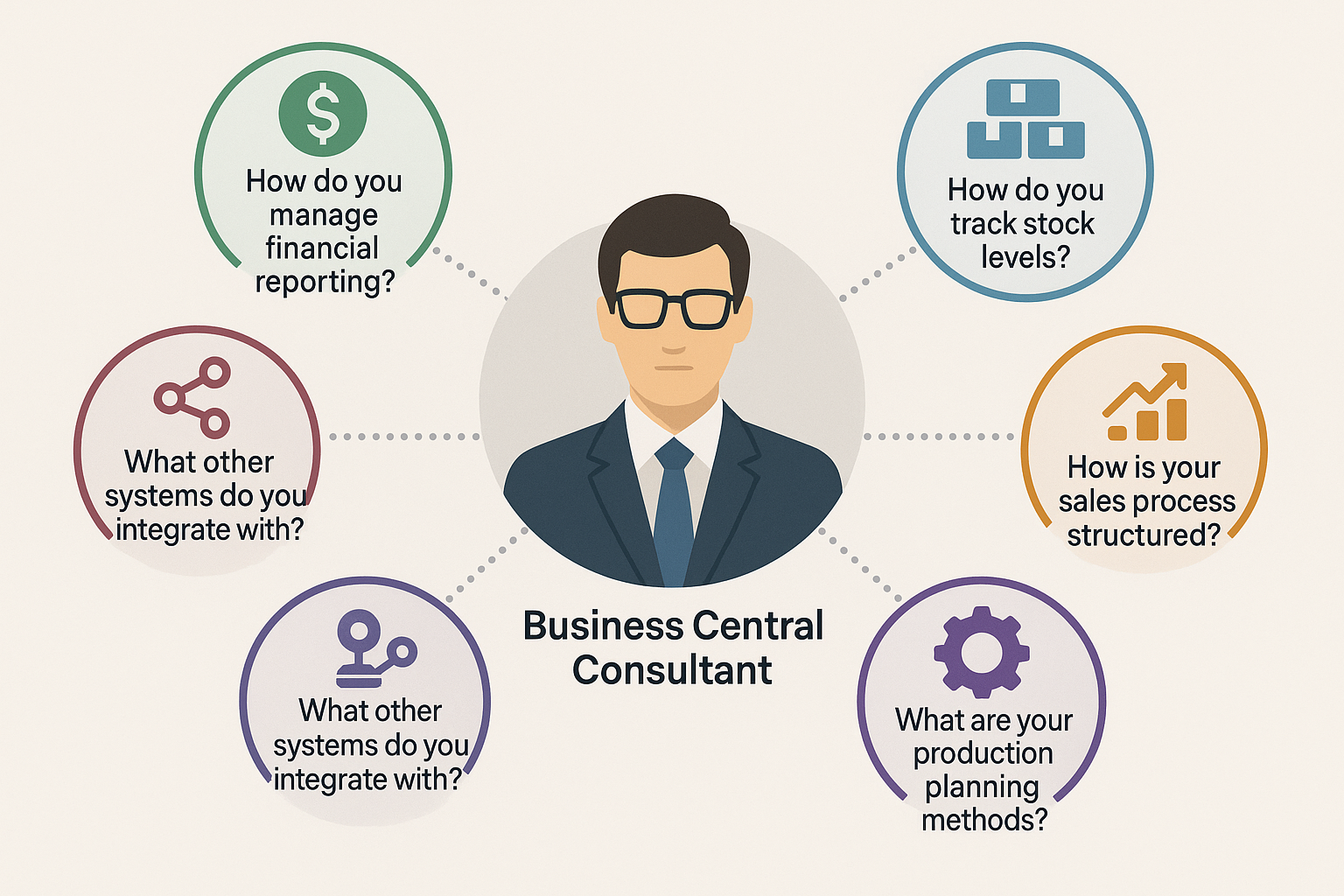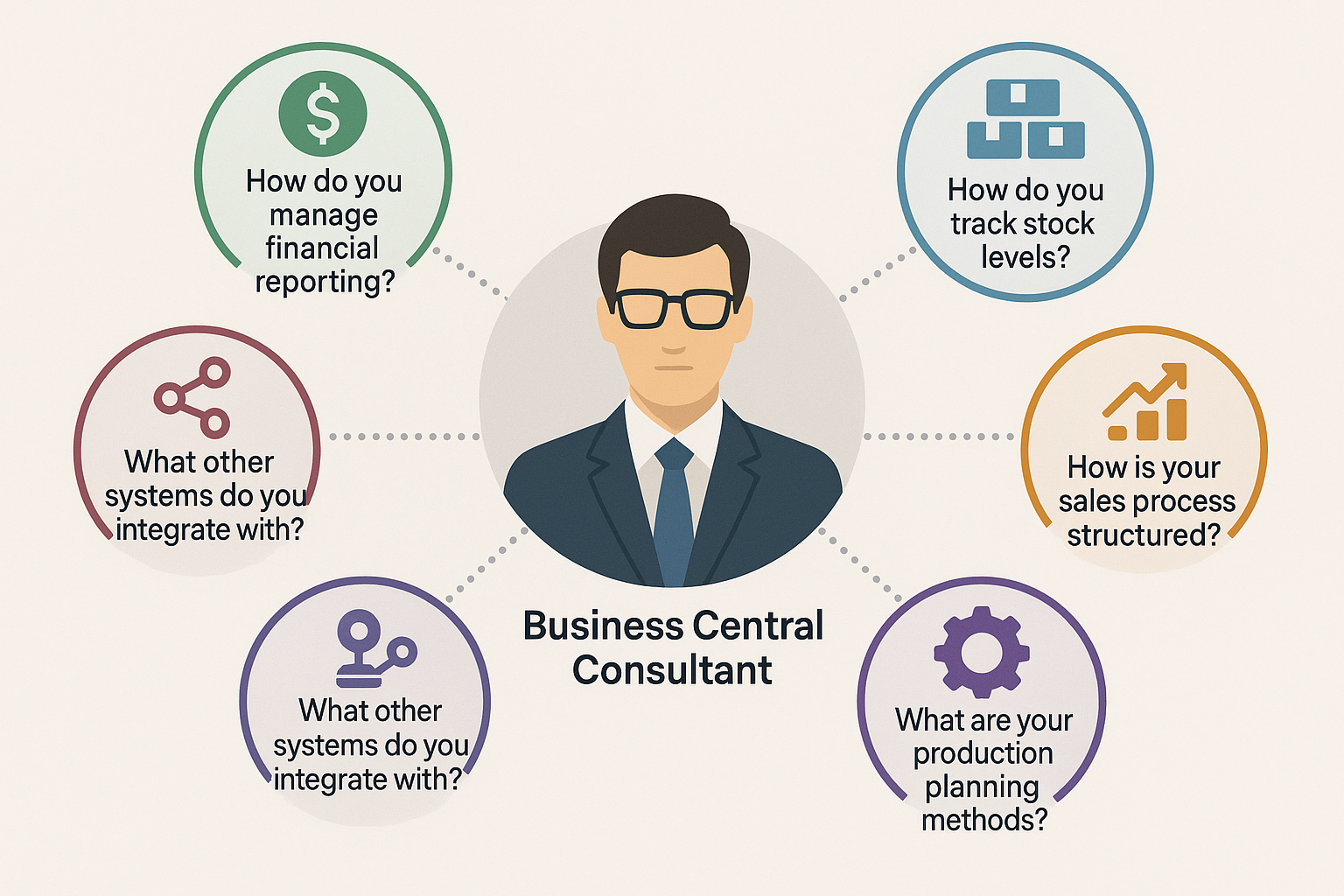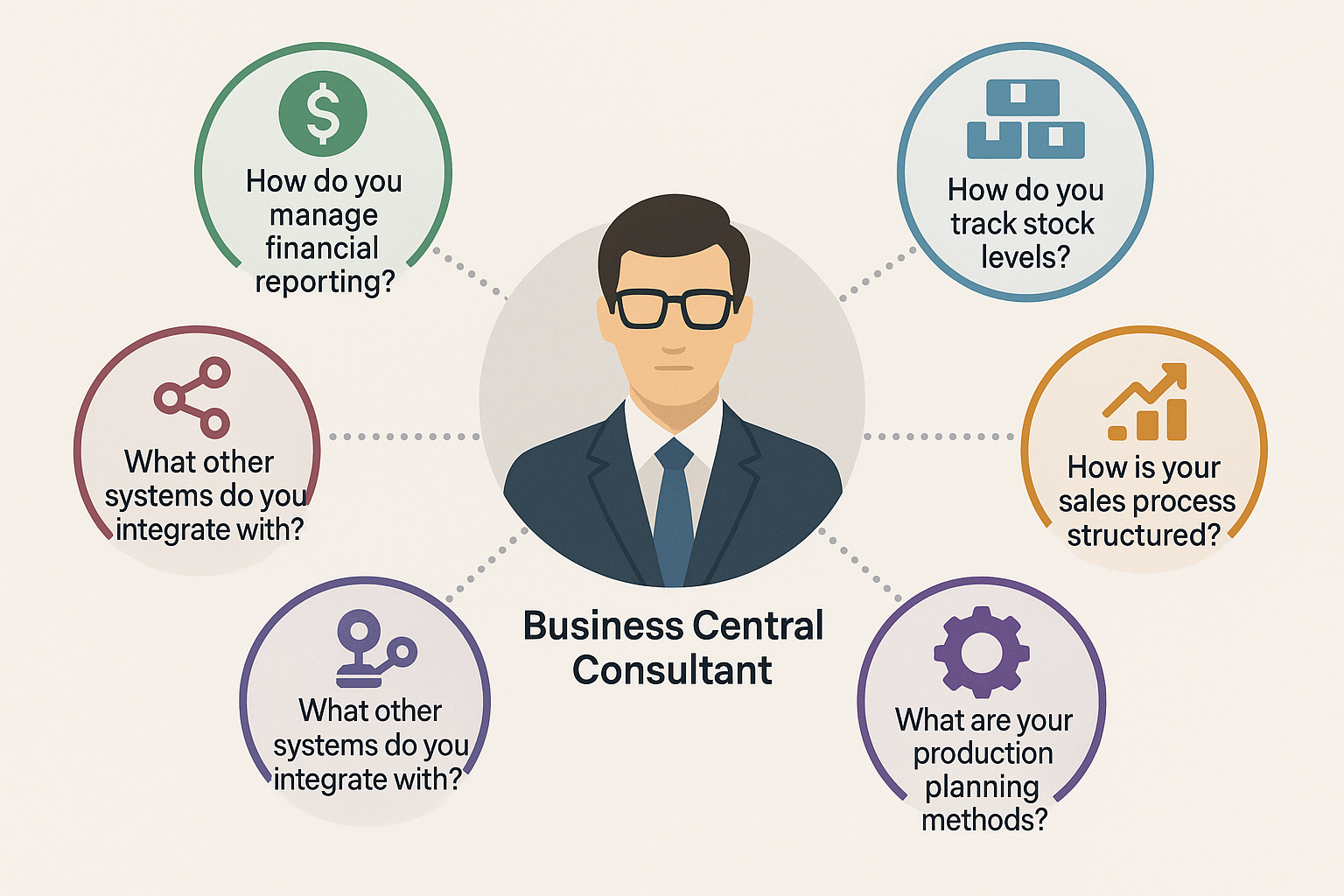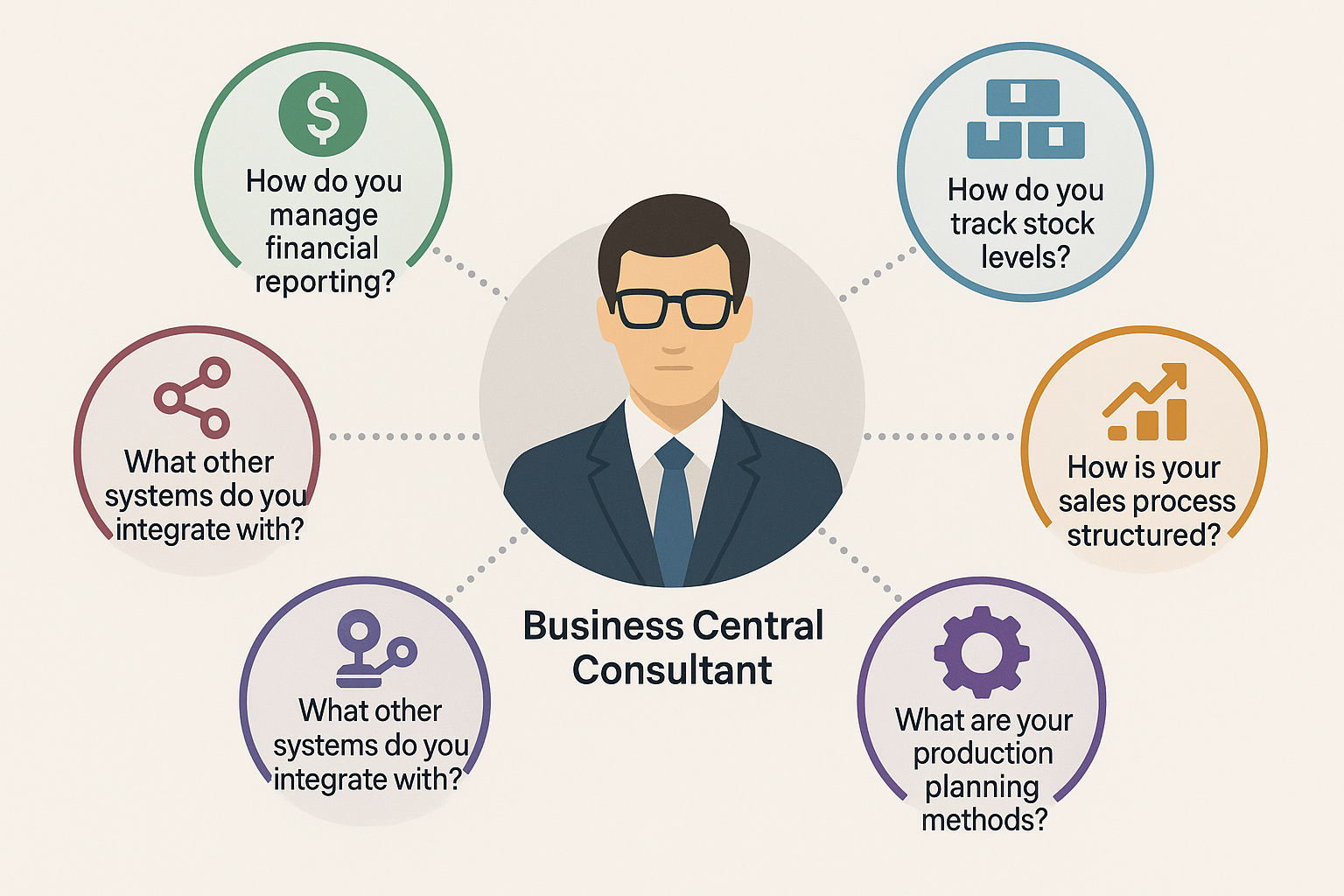Ace Your Interviews - Prompting for Effective Customer Interaction Preparation
Welcome to the fourth installment in our series on practical prompt engineering for Business Central consultants! If you’re just joining us, catch up on our journey so far: Why Prompt Engineering is Your New Super Power as a Business Consultant, Laying the Groundwork - Understanding Input and Output Formats for AI Success, and The Power of Templates - Using Meta Prompting to Create Effective Prompts for Recurring Tasks.

- Series Overview
- 🎯 The Strategic Value of AI-Powered Interview Preparation
- 🎭 Mastering the Persona Technique for Interview Preparation
- 💡 Generating Powerful Discovery Questions
- 📋 Creating Structured Interview Outlines
- 🔍 Leveraging AI for Background Research and Summarization
- 🎲 Anticipating and Addressing Potential Pain Points
- 📊 Measuring Interview Effectiveness
- 🚀 Advanced Interview Preparation Techniques
- 🎯 Putting It All Together: Your Interview Preparation Playbook
- 🔮 Looking Ahead
- 💡 Key Takeaways
Series Overview
| Phase | Posts | Focus | Your Progress |
|---|---|---|---|
| Foundation | 1-2 | Understanding prompt engineering basics & structure | ✅ Complete |
| Optimization | 3 | Meta-prompting & template creation | ✅ Complete |
| Application | 4-5 | Client interactions & requirements gathering | 📍 You are here |
| Implementation | 6-7 | AL development & debugging with AI | 🔄 Advanced topics |
In this post (Part 4): We’ll transform how you prepare for customer interviews by using AI to generate insightful questions, create structured interview outlines, and anticipate client pain points—turning every discovery session into a strategic opportunity for Business Central success.
Picture this: You’re about to meet with a prospective client who’s considering Business Central for their growing retail chain. You have one hour to understand their complex inventory challenges, multi-location requirements, and integration needs. How do you ensure you ask the right questions? How do you avoid missing critical pain points that could derail the project later?
The answer lies in strategic AI-powered interview preparation. Let’s explore how prompt engineering can transform your customer interactions from reactive conversations to proactive consultations.
🎯 The Strategic Value of AI-Powered Interview Preparation
In the fast-paced world of Business Central consulting, preparation time is often limited. Yet, the quality of your initial customer interviews can make or break a project. According to research from leading academic sources and industry analysts, more than 60% of ERP failures tie back to the initial phases of requirement gathering and system selection, where misalignments occur between ERP capabilities and business processes.
AI-powered preparation offers three game-changing advantages:
- Comprehensive Coverage: AI helps ensure you don’t miss critical areas of inquiry
- Industry-Specific Insights: Leverage collective knowledge about common pain points in specific verticals
- Time Efficiency: Transform hours of preparation into minutes of strategic prompting
🎭 Mastering the Persona Technique for Interview Preparation
The persona technique is one of the most powerful tools in your prompt engineering arsenal. By asking AI to adopt the perspective of an experienced Business Central consultant, you tap into specialized knowledge patterns that generate more relevant and insightful outputs.
The Anatomy of an Effective Persona Prompt
| Component | Purpose | Example |
|---|---|---|
| Role Definition | Establishes expertise level and domain | “Act as a seasoned Business Central consultant with 10+ years of experience” |
| Context Setting | Provides situational awareness | “…specializing in manufacturing implementations” |
| Task Specification | Clarifies the desired output | “…preparing for a discovery session with a mid-sized manufacturer” |
| Constraints | Focuses the response | “…who is currently using legacy ERP or accounting software and needs to scale” |
Persona Variations for Different Scenarios
For Financial Focus:
Act as a Business Central financial consultant with deep expertise in multi-entity
consolidations. You're preparing to interview the CFO of a company with 5 subsidiaries
across different countries. Generate questions that will uncover their consolidation
pain points, reporting requirements, and compliance needs.
For Operations Focus:
Act as a Business Central operations specialist who has implemented BC for 50+
manufacturing companies. You're meeting with the production manager of an automotive
parts manufacturer. Create questions that explore their shop floor processes,
quality control needs, and supply chain challenges.
For Technical Integration:
Act as a Business Central technical architect with extensive API and integration
experience. You're interviewing the IT director about connecting BC with their
existing CRM, e-commerce platform, and warehouse management system. Develop
technical discovery questions that assess integration complexity and data flow requirements.
💡 Generating Powerful Discovery Questions
Let’s move beyond generic questions to create targeted inquiries that uncover real business needs. Here’s a systematic approach to generating effective discovery questions using AI.
The Question Generation Framework
Level 1: Surface Questions (Difficulty: ⭐ Beginner | Time: 5 minutes) These establish basic facts and current state:
Generate 10 factual questions about a company's current inventory management
processes in preparation for a Business Central implementation. Focus on
volumes, locations, and basic workflows.
Level 2: Diagnostic Questions (Difficulty: ⭐⭐ Intermediate | Time: 10 minutes) These uncover problems and inefficiencies:
Act as a Business Central consultant analyzing inventory challenges. Create
10 diagnostic questions that will help identify pain points, bottlenecks,
and inefficiencies in a retail company's current inventory management.
Include questions about stockouts, overstock situations, and visibility issues.
Level 3: Strategic Questions (Difficulty: ⭐⭐⭐ Advanced | Time: 15 minutes) These explore future vision and success metrics:
As an experienced Business Central strategist, develop 10 forward-looking
questions that explore how improved inventory management could transform
this retail company's competitive position. Include questions about growth
plans, customer experience goals, and measurable business outcomes.
Industry-Specific Question Banks

| Industry | Key Areas to Explore | Sample AI-Generated Questions |
|---|---|---|
| Manufacturing | Production planning, shop floor control, quality management | “How do you currently handle production scheduling conflicts when customer priorities change?” |
| Retail | Multi-channel inventory, customer loyalty, seasonal planning | “What percentage of your inventory decisions are based on predictive analytics versus historical data?” |
| Distribution | Warehouse optimization, route planning, drop-shipping | “How do you manage inventory ownership during drop-ship transactions?” |
| Professional Services | Project accounting, resource planning, time tracking | “What’s your current process for recognizing revenue on long-term projects?” |
Advanced Prompting for Question Generation
Chain Prompting for Comprehensive Coverage:
Step 1: "List the top 5 business processes that typically cause pain for
growing retail companies considering Business Central."
Step 2: "For each process identified above, generate 3 probing questions
that would uncover specific challenges a retailer might face."
Step 3: "Now add a follow-up question for each that explores the business
impact of these challenges."
📋 Creating Structured Interview Outlines
A well-structured interview guide ensures comprehensive coverage while maintaining natural conversation flow. Here’s how to use AI to create professional interview outlines that adapt to different scenarios.
The DISCOVER Framework
Using AI, we can generate interview outlines following this proven framework:
- Define current state
- Identify pain points
- Specify desired outcomes
- Clarify constraints
- Outline success metrics
- Validate assumptions
- Establish timeline
- Review next steps
Sample Prompt for Framework-Based Outline:
Create a 60-minute Business Central discovery session outline following the
DISCOVER framework for a wholesale distributor. Include:
- Time allocations for each section
- Key questions for each phase
- Transition statements between sections
- Areas where demos might be appropriate
Format as a structured agenda with facilitator notes.
Dynamic Interview Structures

Different client situations require different interview approaches. Here’s how to generate appropriate structures:
| Scenario | Interview Focus | AI Prompt Template |
|---|---|---|
| Greenfield Implementation | Vision and requirements | “Create an interview outline for a company with no existing ERP, focusing on business vision and process design” |
| System Replacement | Gap analysis and migration | “Develop an interview structure for migrating from [Current System] to Business Central, emphasizing data migration and process changes” |
| Expansion/Upgrade | New capabilities needed | “Generate an interview guide for a current BC user looking to expand into new modules or capabilities” |
| Rescue Project | Problem identification | “Design an interview outline for taking over a troubled Business Central implementation, focusing on issue identification and prioritization” |
Time-Boxed Interview Templates
30-Minute Executive Briefing:
Act as a Business Central consultant preparing for a brief executive meeting.
Create a focused 30-minute interview outline that:
- Captures strategic business drivers (10 min)
- Identifies top 3 pain points (10 min)
- Discusses success criteria (5 min)
- Establishes next steps (5 min)
Include suggested executive-level questions for each section.
2-Hour Deep Dive Session:
Design a comprehensive 2-hour discovery session outline for Business Central
implementation in a manufacturing company. Structure it as:
- Current State Assessment (45 min)
- Future State Visioning (30 min)
- Technical Requirements (30 min)
- Implementation Approach (15 min)
Include break points and energy management techniques.
🔍 Leveraging AI for Background Research and Summarization
Walking into a client meeting well-informed about their business, industry challenges, and competitive landscape establishes immediate credibility. Here’s how to use AI for efficient background preparation.
The Pre-Interview Intelligence Gathering Process
Step 1: Company Intelligence Synthesis
Summarize the following information about [Company Name] in preparation for
a Business Central consultation:
- Industry: [Industry]
- Size: [Employee count and revenue if known]
- Current systems: [Known systems]
- Recent news: [Any relevant news items]
Focus on factors that might influence their ERP needs and implementation approach.
Highlight potential pain points common to similar companies.
Step 2: Industry Challenge Analysis
Act as a Business Central industry expert. Based on current trends in the
[specific industry] sector, identify:
1. Top 5 operational challenges companies typically face
2. How Business Central addresses each challenge
3. Common objections or concerns from this industry
4. Success metrics that resonate with [industry] executives
Step 3: Competitive Landscape Assessment
Analyze the competitive landscape for [Company Name] in [Industry].
Generate insights about:
- How advanced ERP capabilities could provide competitive advantage
- Industry-specific Business Central features they should consider
- Integration needs based on common industry tech stacks
- Regulatory or compliance requirements affecting ERP choice
Creating Executive Briefing Documents
Transform your AI-gathered intelligence into professional briefing documents:
| Section | AI Prompt | Purpose |
|---|---|---|
| Company Snapshot | “Create a one-paragraph executive summary of [Company] highlighting ERP-relevant factors” | Quick context setting |
| Industry Challenges | “List 5 bullet points of industry-specific challenges that Business Central can address” | Relevance demonstration |
| Potential Quick Wins | “Identify 3 immediate improvements BC could provide based on common [industry] pain points” | Value proposition |
| Risk Factors | “Highlight 3 potential implementation challenges specific to [company size/industry]” | Credibility building |
| Success Stories | “Summarize how similar companies have succeeded with Business Central” | Confidence building |
🎲 Anticipating and Addressing Potential Pain Points
The ability to anticipate client challenges before they voice them is what separates good consultants from great ones. Here’s how to use AI to develop this prescient capability.
Pain Point Prediction Framework

Industry-Specific Pain Point Analysis:
Act as a Business Central consultant with deep experience in [Industry].
Based on a company with these characteristics:
- Size: [Employee count]
- Current System: [Existing ERP/tools]
- Growth Stage: [Startup/Growing/Mature]
Predict:
1. Top 5 operational pain points they're likely experiencing
2. Hidden challenges they might not recognize yet
3. Change management concerns specific to their situation
4. Technical debt that could impact implementation
For each point, explain why it's likely and how to sensitively explore it in conversation.
The Pain Point Discovery Matrix
| Visible Symptoms | Likely Root Causes | Discovery Questions | BC Solution Approach |
|---|---|---|---|
| “Reports take too long” | Manual data consolidation | “Walk me through your month-end close process” | Automated financial reporting |
| “Can’t find inventory” | No real-time tracking | “How do you currently know what’s in each location?” | Multi-location inventory |
| “Customers complain about delays” | Poor visibility into fulfillment | “How do customers track their order status?” | Customer portal integration |
| “Pricing errors frequent” | Manual price management | “How do you manage customer-specific pricing?” | Advanced pricing rules |
Proactive Problem-Solving Prompts
For Change Management Concerns:
Generate a list of likely change management concerns for a [Industry] company
with [X] employees moving from [Current System] to Business Central. For each concern:
- Explain why it typically arises
- Provide a probing question to surface it
- Suggest how to position BC's change management features
- Include a success story reference point
For Technical Integration Challenges:
As a Business Central technical architect, anticipate integration challenges for a company using:
- CRM: [System]
- E-commerce: [Platform]
- Other tools: [List]
Create a technical discovery checklist that includes:
- Data volume considerations
- API availability assessment
- Real-time vs. batch processing needs
- Security and compliance requirements
📊 Measuring Interview Effectiveness
To continuously improve your interview skills, track these key metrics:
Interview Success Metrics Dashboard
| Metric | How to Measure | Target | Why It Matters |
|---|---|---|---|
| Coverage Completeness | % of planned topics discussed | 90%+ | Ensures thorough discovery |
| Pain Point Discovery Rate | # of unknown issues uncovered | 3-5 per interview | Validates preparation quality |
| Next Step Conversion | % leading to follow-up meetings | 80%+ | Indicates engagement success |
| Time-to-Proposal | Days from interview to proposal | <7 days | Shows preparation efficiency |
| Proposal Win Rate | % of proposals accepted | 60%+ | Ultimate success measure |
Post-Interview Improvement Prompts
Based on these interview notes: [paste notes]
And this original interview outline: [paste outline]
Analyze:
1. Which planned questions yielded the most valuable insights?
2. What important topics emerged that weren't in the original plan?
3. Where did the conversation stall or lose focus?
4. What follow-up questions should have been asked?
Suggest improvements for the next similar interview.
🚀 Advanced Interview Preparation Techniques
The Scenario Planning Approach
Prepare for different conversation directions:
Create 3 different interview flow scenarios for a Business Central discovery session with a growing retailer:
Scenario A: They're mainly concerned about inventory accuracy
Scenario B: Their focus is on improving customer experience
Scenario C: They need better financial visibility
For each scenario, provide:
- Adjusted question priorities
- Relevant BC features to highlight
- Demo suggestions
- Success stories to reference
The Stakeholder Matrix Method
Different stakeholders require different approaches:
| Stakeholder | Primary Concerns | AI Prompt for Questions |
|---|---|---|
| CFO | ROI, compliance, reporting | “Generate financial-focused questions for a CFO considering Business Central” |
| Operations Manager | Efficiency, user adoption | “Create operational discovery questions focusing on daily workflows” |
| IT Director | Integration, security, maintenance | “Develop technical assessment questions for BC implementation” |
| End Users | Ease of use, training needs | “Generate user experience questions for front-line staff” |
The Challenge-Solution Mapping Technique
Based on common challenges in [Industry], create a challenge-solution map where:
- Each challenge has 3 probing questions to confirm its presence
- Each confirmed challenge maps to specific BC capabilities
- Each capability includes a proof point or success metric
Format as a decision tree for use during interviews.
🎯 Putting It All Together: Your Interview Preparation Playbook
Here’s your step-by-step playbook for AI-powered interview preparation:
1 Week Before the Interview
- Generate company background summary (15 min)
- Create industry pain point analysis (20 min)
- Develop role-specific question banks (30 min)
3 Days Before
- Create structured interview outline (20 min)
- Generate scenario-based response strategies (15 min)
- Prepare challenge-solution talking points (15 min)
1 Day Before
- Review and refine questions based on latest information (10 min)
- Create executive briefing document (15 min)
- Generate potential objection responses (10 min)
Day of Interview
- Quick refresh with AI-generated summary (5 min)
- Final question priority adjustment (5 min)
🔮 Looking Ahead
In our next blog post, we’ll dive deep into transforming interview insights into comprehensive feature requirements. You’ll learn how to use AI to create detailed specifications, user stories, and implementation roadmaps that set your Business Central projects up for success.
💡 Key Takeaways
-
Persona Power: Using the persona technique with AI generates more relevant, expert-level interview questions than generic prompting
-
Structured Success: AI-generated interview outlines ensure comprehensive coverage while maintaining conversational flow
-
Anticipation Advantage: Predicting pain points through AI analysis helps you guide conversations more effectively
-
Background Brilliance: AI-powered research and summarization saves hours while ensuring you’re fully prepared
-
Continuous Improvement: Using AI to analyze interview outcomes helps refine your approach for future success
Remember, the goal isn’t to script every moment of your customer interactions. It’s to be so well-prepared that you can focus entirely on listening, understanding, and building trust. With AI as your preparation partner, every interview becomes an opportunity to demonstrate expertise and create value.
Ready to transform your next customer interview? Start with one technique from this post and experience the difference that strategic AI-powered preparation can make.
Happy interviewing!